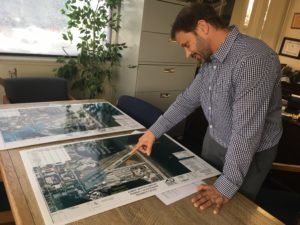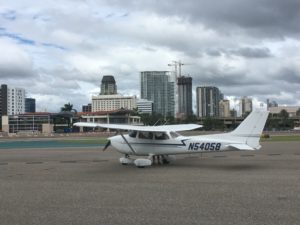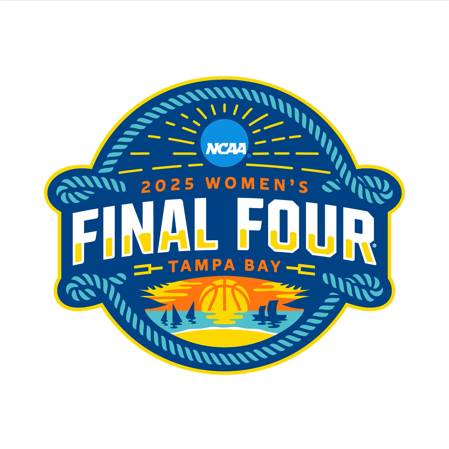By Devin Rodriguez
If the main runway at Albert Whitted Airport is shifted a quarter mile to the east, the planes that buzz the campus would be higher and quieter. It might be possible for the growing university to have taller buildings, too.
But the runway extension would cost $12.5 million and require a host of environmental permits.
Those are the some of the tentative conclusions of consultants that were hired by the city of St. Petersburg to explore the feasibility and cost of extending the runway.
The runway has long been a point of contention between Albert Whitted and the university. Because part of USFSP lies directly beneath the main runway’s flight path, some campus buildings cannot exceed certain heights.

University officials told the consultants that the flights that zoom overhead are “low, noisy and prevent the upward expansion of any facilities on their property,” the consultants’ report says. “Although they do understand the transportation and economic benefits the airport offers to the community, the overflights have been cause for concern for many years.”
The report notes that Bayboro, Coquina and Davis halls and the Science and Technology Building all lie within the limits of what federal aviation officials call “the runway protection zone.”
Because university buildings are considered “incompatible land uses” in such protection zones, the consultants say, the runway should be shifted 1,257 feet – or about a quarter mile – into Tampa Bay to the east.
That would put the campus buildings outside the runway protection zone and make possible what Albert Whitted manager Richard Lesniak has called “vertical development opportunities” for the university and other airport neighbors.
In the past, city officials have said a runway extension would also make it possible for more small, corporate jets to use the airport.
With more small and medium-sized corporate aircraft, the airport would generate more revenue for the city and make the city itself “more appealing as a place to locate/relocate major corporations,” Clay Smith, the city’s downtown enterprise facilities director, told the City Council in 2015.
But Lesniak downplayed that potential benefit in an interview with The Crow’s Nest last week.
“I don’t think anybody has a grand vision of landing big airplanes at this airport,” he said. “We will be able to hopefully incorporate more corporate airplanes, but we already do that now. It’s not to the point where it would radically change the way our airport functions.”
The feasibility study, which cost $50,000 in mostly state funds, was conducted by American Infrastructure Development Inc. of Tampa and Environmental Science Associates of Tampa.
The study is part one of a two-part endeavor, Lesniak said. Still to come from the consultants is an assessment of the economic impact the runway extension might have.
That assessment will look at on- and off-airport impacts and is not included in the cost of the feasibility study.
The consultants stress that a runway extension would be both expensive – $12.5 million in 2016 dollars – and time-consuming. Lesniak estimates it would take eight to 10 years to complete.
If the City Council wants to proceed, the airport would have to update its master plan with federal aviation officials. That process that could take 18 to 24 months, according to Lesniak.
The proposed extension also would have to pass muster with state and federal agencies like Florida Department of Environmental Protection, the Southwest Florida Water Management District, the Florida Fish and Wildlife Conservation Commission and the U.S. Army Corps of Engineers.
That would take another 18 to 24 months, Lesniak said.
Only then could construction begin.
The City Council could stop the proposal in its tracks, however. Although the council voted unanimously in November 2015 to authorize the feasibility study, several members voiced environmental concerns about extending the runway farther into Tampa Bay.
A proposal to extend the runway also would likely draw opposition from the editorial board of the Tampa Bay Times, which for decades has favored closing the 110-acre airport and putting the prime waterfront land to better public use.
The little municipal airport opened in 1929, decades before classes began at what is now USF St. Petersburg in 1965. But it was not until the campus began to expand in the late 1970s that proximity to the airport became an issue.
Under city, state and federal regulations and laws, buildings that lie beneath or near an airport’s flight patterns cannot exceed certain heights.

That meant that the first new buildings in the early 1980s – now called Davis, Bayboro and Coquina halls – could have only two stories. Campus buildings that are not directly underneath the flight patterns can be taller.
If the runway is extended, it probably would not be financially feasible to add floors to campus buildings that were designed for two stories, university officials have said. It would be cheaper to erect new buildings.
Albert Whitted has two runways.
The main runway, which begins just across First Street S from the university, runs 3,674 feet to the northeast and handles about 70 percent of the departures and landings at the airport, according to the consultants’ study.
The shorter, north-south runway is 2,864 feet long and accommodates the remaining 30 percent “when weather and winds are favorable for its use.”
Airport officials and people who use the airport say it has a good safety record.
But it was concerns about safety that prompted City Council discussions in late 2014 that led eventually to talk of extending the main runway.
According to the Tampa Bay Times, there have been four accidents at the airport in 2017:
** On Feb. 11, a plane carrying two people crashed into the seawall at the east end of the main runway. No one was hurt.
** On March 1, a student pilot escaped serious injury when his plane crashed while he was attempting a landing on the north-south runway.
** On March 9, another pilot escaped injury when her plane skidded off a runway.
** On Sept. 1, a small plane rolled off the end of the north-south runway into the bay, but neither the pilot nor passenger was seriously injured.
In 2014, a small plane approaching the airport from the north barely missed hitting high-rise condo towers before crashing into Vinoy Park, less than a mile north of the airport. Two of the four occupants were seriously injured.
Two years earlier, one man died and another was injured when their plane nose-dived into the main runway shortly after taking off.
The plane came to rest about 100 feet from the fence at the end of the runway, just across the street from USFSP, according to the National Transportation Safety Board.

Information from the Tampa Bay Times and “St. Petersburg and the Florida Dream: 1888-1950” by Raymond Arsenault was used in this report.



